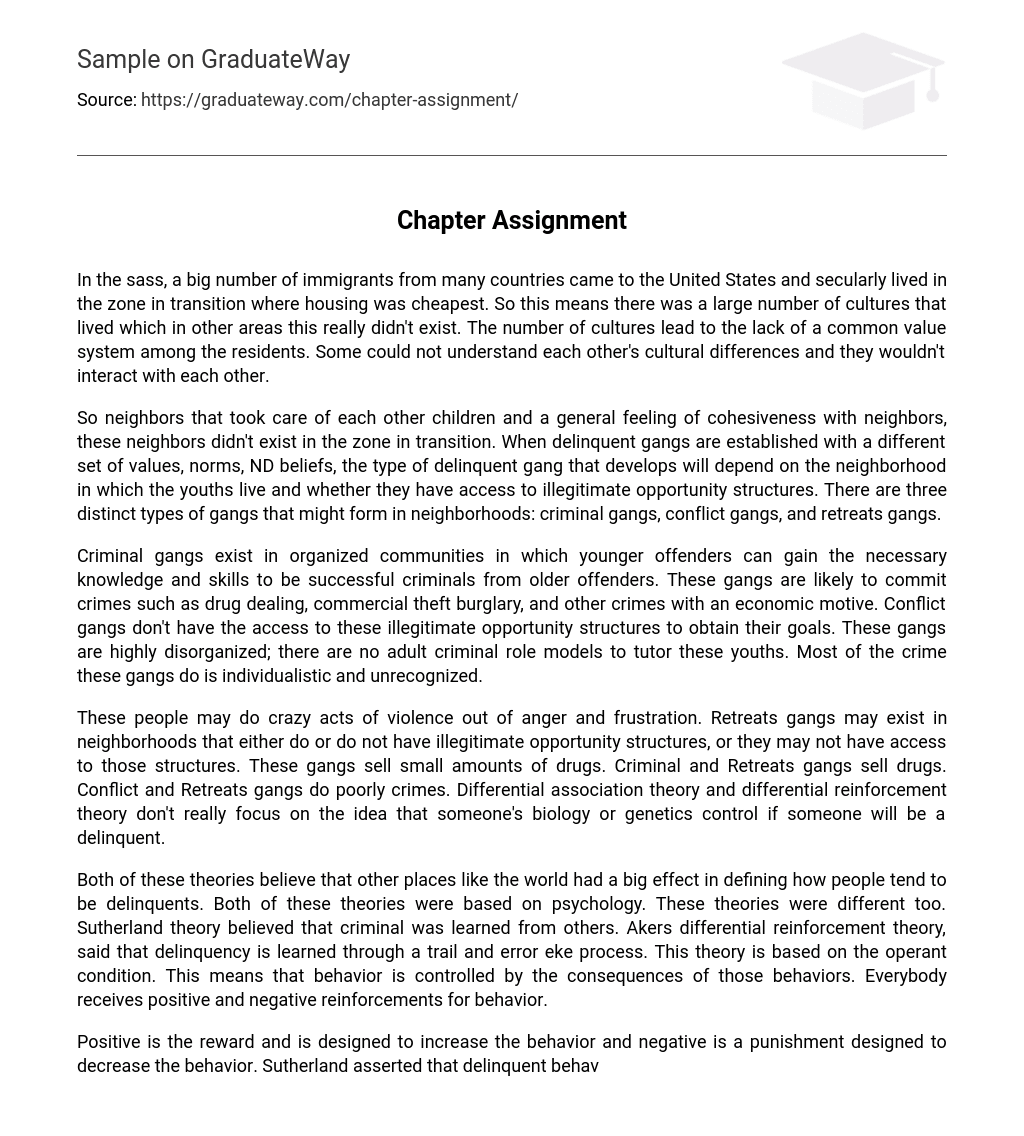In the sass, a big number of immigrants from many countries came to the United States and secularly lived in the zone in transition where housing was cheapest. So this means there was a large number of cultures that lived which in other areas this really didn’t exist. The number of cultures lead to the lack of a common value system among the residents. Some could not understand each other’s cultural differences and they wouldn’t interact with each other.
So neighbors that took care of each other children and a general feeling of cohesiveness with neighbors, these neighbors didn’t exist in the zone in transition. When delinquent gangs are established with a different set of values, norms, ND beliefs, the type of delinquent gang that develops will depend on the neighborhood in which the youths live and whether they have access to illegitimate opportunity structures. There are three distinct types of gangs that might form in neighborhoods: criminal gangs, conflict gangs, and retreats gangs.
Criminal gangs exist in organized communities in which younger offenders can gain the necessary knowledge and skills to be successful criminals from older offenders. These gangs are likely to commit crimes such as drug dealing, commercial theft burglary, and other crimes with an economic motive. Conflict gangs don’t have the access to these illegitimate opportunity structures to obtain their goals. These gangs are highly disorganized; there are no adult criminal role models to tutor these youths. Most of the crime these gangs do is individualistic and unrecognized.
These people may do crazy acts of violence out of anger and frustration. Retreats gangs may exist in neighborhoods that either do or do not have illegitimate opportunity structures, or they may not have access to those structures. These gangs sell small amounts of drugs. Criminal and Retreats gangs sell drugs. Conflict and Retreats gangs do poorly crimes. Differential association theory and differential reinforcement theory don’t really focus on the idea that someone’s biology or genetics control if someone will be a delinquent.
Both of these theories believe that other places like the world had a big effect in defining how people tend to be delinquents. Both of these theories were based on psychology. These theories were different too. Sutherland theory believed that criminal was learned from others. Akers differential reinforcement theory, said that delinquency is learned through a trail and error eke process. This theory is based on the operant condition. This means that behavior is controlled by the consequences of those behaviors. Everybody receives positive and negative reinforcements for behavior.
Positive is the reward and is designed to increase the behavior and negative is a punishment designed to decrease the behavior. Sutherland asserted that delinquent behavior is a function of learning and not a function of either the ability to obtain economic success or of living in a socially disorganized area of a city. Here are nine formal propositions that demonstrate that social interaction ND learning lead to delinquency. The first one is criminal behavior is learned. Sutherland said delinquency is a function of learning.
The second one is criminal behavior is learned in interaction with other persons in a process of communication. The third one is intimate personal groups is the principal part of the learning of criminal behavior. So you can learn delinquent behavior from families such as parents. The fourth one is when you do criminal behavior; you learn the techniques of committing the crime, specific directions of motives, drives, rationalizations, and attitudes. The fifth one is the specific direction of motives and drives is leaned from definitions of the legal codes as favorable or unfavorable.
The sixth one is a person becomes delinquent because of an excess of definitions favorable to violation of the law over definitions unfavorable to violation of the law. A favorable definition happens when a youth is exposed to ideas or behaviors that are deviant. When a juvenile is associating with others, he has obtained more definitions that are favorable to the violation of the law than are unfavorable, and then delinquency is likely to occur. The seventh is preferential associations may vary in frequency, duration, priority, and intensity.
The recurrence and length of time of the connections will decide the amount of consideration adolescents will pay to definitions. Priority includes the significance of reprobate or intelligent conduct to the adolescent. Intensity involves the prestige of the source of a delinquent or intelligent pattern and the emotional reactions related to the associations. The eighth one is the process of learning criminal behavior by association with criminal and anticlerical patterns involves all of the mechanisms that are involved in any other learning.
The ninth is criminal behavior is not explained by those general needs and values, it is a n expression of general needs and values. The need for currency explains unlawful behavior as well as it explains lawful behavior. Strain theorists see delinquency as a result of a lack of opportunity, particularly economic opportunity. American society instills in citizens a desire for financial success but does not provide all individuals equal opportunity to achieve financial success. The people who are likely to be delinquent are the ones who don’t have an equal opportunity. Strained individuals are more prevalent in the lower class.





